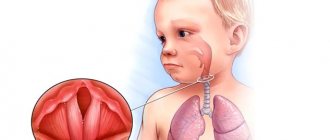Infectious disease specialist
Sinitsyn
Olga Valentinovna
34 years of experience
Highest qualification category of infectious disease doctor
Make an appointment
Diphtheria is a dangerous infectious disease, the mortality rate of which reaches 50%. For a long time, thanks to mass vaccination, this infection was considered completely defeated, but its outbreaks are still recorded in different countries, including developed ones. In recent years, due to the increase in incidence, diphtheria has been discussed again. According to WHO, in 2022, 16.5 thousand cases of diphtheria were recorded worldwide. In Russia, the epidemiological situation is still under control, because 97% of the population has been vaccinated. However, an increase in morbidity due to the refusal of some parents to vaccinate their children is also observed in our country.
The causative agent of diphtheria. Methods of transmission
The causative agent of diphtheria is the bacterium Corynebacterium diphtheria, which was first discovered and described by Edwin Klebs in 1883. The diphtheria bacillus is quite resistant to external factors. She can live for weeks: in saliva and water - two, in milk - three, in dust - up to five. Of particular danger to humans is its toxin, to which almost all organs of the human body are sensitive, but most of all the heart, kidneys, adrenal glands, and nervous system. The poison blocks protein synthesis in cells, which causes dangerous functional and structural changes that lead to death. The toxin acts both locally and systemically if it enters the blood and lymph. In severe cases, it can cause myocarditis or peripheral neuropathy, but most often the patient has trouble breathing due to the accumulation of dead tissue in the throat and tonsils.
The diphtheria bacillus is transmitted from an infected person in different ways:
- airborne;
- contact-household (this method of transmission is more common in hot countries where the cutaneous form of diphtheria is present; in temperate latitudes it is extremely rare);
- through food.
The more pronounced the course of the disease, the more bacteria the patient releases into the environment. But infection is also possible from a completely healthy person who is a carrier of the pathogen. However, the contagiousness of diphtheria is not as high as, for example, measles. Out of ten people in contact with the patient, only one or two can become infected.
Diphtheria has the following periods:
- incubation (2-10 days);
- the height of the illness;
- recovery (in the absence of treatment, death cannot be ruled out).
Epidemiology
Diphtheria is an anthroponotic infection. The reservoir is a person: a patient with any clinical form of diphtheria, a convalescent, as well as a “healthy” bacterial excretor of toxigenic C.Diphtheriae. Patients have the greatest intensity of excretion, but the epidemic significance of carriers is greater and intensifies during the seasonal rise of ARVI, because the intensity of C. Diphtheriae excretion during ARVI-respiratory syndrome in carriers increases. The duration of carriage varies from 1-2 weeks to several months.
The main route of transmission is airborne, but contact transmission through household items (use of shared utensils, napkins, handkerchiefs, cigarettes), and nutritional transmission through contaminated products (milk, ice cream) cannot be excluded. Susceptibility to diphtheria in non-immune individuals is high in any age group.
Passive (maternal), immunity persists in children of the first year of life up to 3 months. Among adults, workers in child care institutions, medical workers, and people working in the catering industry are at occupational risk of contracting diphtheria. Risk groups for severe disease include immunosuppressed persons with chronic diseases of the ENT organs, respiratory system, diabetes mellitus, systemic diseases, etc., chronic intoxications (household and professional intoxication with chemical compounds, chronic alcoholism), persons leading an antisocial lifestyle (homeless people) ). It was these categories of people that provided a high percentage of severe forms of the disease and mortality during the last diphtheria epidemic in Russia.
Antibacterial post-infectious immunity is predominantly local in nature, is not stable, and does not provide reliable protection against re-infection. Specific prevention is aimed at reducing severe - toxic forms of diphtheria and its consequences and is achieved by using AD-toxoid (diphtheria toxoid - exotoxin detoxified with formaldehyde and adsorbed with aluminum hydroxide). It is included as a component in associated vaccines.
In Russia the following are used: DTP - adsorbed pertussis-diphtheria-tetanus vaccine, ADS - adsorbed diphtheria-tetanus toxoid; ADS-M - adsorbed diphtheria-tetanus toxoid with reduced antigen content; AD-M is an adsorbed diphtheria toxoid with a reduced antigen content. The calendar of preventive vaccinations with these drugs is as follows: 3-4-5 months - DTP; 18 months - DPT; 6 years - ADS-M; 11 years old - AD-M; 16-17 years old - ADS-M; adults - ADS-M (AD-M) once every 10 years. In addition to these drugs, foreign vaccines have been registered and approved for use (Pasteur-Merrier, France): Tetracok (against whooping cough, diphtheria, tetanus, polio); D.T.Vax (against diphtheria and tetanus in children under 6 years of age); D.T.Adult (against diphtheria and tetanus in children over 6 years old). In Russia, new vaccines have been proposed for the simultaneous prevention of whooping cough, diphtheria, tetanus, hepatitis B (Bubo-Kok, Bubo-M).
Classification of the disease
Diphtheria is classified according to several criteria.
In terms of prevalence, the disease can be localized, when one organ is affected, and widespread, accompanied by larger-scale lesions.
The following forms differ in localization and toxicity:
- diphtheria of the oropharynx (frequency – 92%):
- localized - catarrhal, island and film;
- widespread - plaque extends beyond the oropharynx;
- subtoxic, toxic (3rd degree of toxicity), hypertoxic, hemorrhagic;
- localized, manifested by inflammation of the larynx;
- common - inflammation extends beyond the larynx and invades the trachea;
- descending - in addition to the larynx and trachea, damage to the bronchi is noted;
Diphtheria of the larynx. Diphtheria croup
Currently, due to the decrease in the incidence of diphtheria, diphtheria croup (acute inflammation of the larynx) develops rarely, mainly in children 1 to 3 years old. Primary croup (isolated damage to the larynx) is rare. Diphtheria of the larynx and trachea (common croup) and descending croup, when inflammation spreads from the larynx to the trachea and bronchi, are most often recorded.
The development of stenosis of the respiratory tract is promoted by muscle spasm and swelling of the mucous membrane of the larynx, which is detected during laryngoscopy and bronchoscopy. The severity of the disease depends on the degree of airway obstruction.
Diphtheria croup goes through several stages in its development.
Signs and symptoms of diphtheria croup in the catarrhal stage
The stage of catarrhal inflammation (dysphonic stage) is characterized by the appearance of a rough “barking” cough and hoarseness in the child. The duration of the dysphonic stage is about 7 days in adults and 1 - 3 days in children. If there is no specific treatment, then after 1 - 3 days this stage passes into the second - stenotic phase.
Rice. 9. In the photo there is diphtheria of the larynx. On the right, a filmy coating on the vocal cord is visible.
Signs and symptoms of diphtheria croup in the stenotic stage
During the stenotic stage, the voice becomes hoarse and soon disappears completely (aphonia), the cough is silent, breathing becomes noisy, and auxiliary muscles begin to take part in the act of breathing. The duration of the stenotic stage ranges from several hours to 2 - 3 days. Without specific treatment, asphyxia quickly develops. Tracheostomy or intubation is used to prevent suffocation.
Signs and symptoms of diphtheria croup in the asphyxial stage
During the asphyxial stage, breathing quickens, the pulse becomes thready, blood pressure decreases, cyanosis develops, and convulsions appear. Death occurs from suffocation.
Narrowing of the larynx can occur even with mild diphtheria, when exfoliated films prevent air from entering the respiratory tract
Rice. 10. The photo shows a child with diphtheria croup. Tracheostomy or intubation is used to prevent suffocation.
Diphtheria symptoms
In temperate latitudes, oropharyngeal diphtheria is most common. The symptoms initially resemble a sore throat. The disease begins with fever and weakness, in addition the following symptoms are observed:
- swelling of the mucous membrane of the oropharynx and neck;
- gray-white plaque on the tonsils;
- enlargement of the submandibular and cervical lymph nodes.
In a localized form, the plaque does not extend beyond the tonsils, the intoxication is not intense, and the pain when swallowing is not very acute. If the patient has a strong immune system, recovery is possible even without the administration of anti-diphtheria serum, but the disease is fraught with serious complications.
The most common form of diphtheria is the membranous form, in which the plaque on the tonsils looks like a dense film with clear edges. When you try to remove it with a spatula, the tonsils begin to bleed. The throat swells and hurts very much. The wider the spread of plaque, the more intoxication of the body is manifested.
Toxic diphtheria is dangerous. Without timely administration of serum, it turns into hypertoxic or hemorrhagic forms. In the toxic form, the disease develops very quickly, the temperature rises sharply to 40 °C. Symptoms of general intoxication are clearly expressed: severe weakness, headache, pain in the throat and neck, and sometimes in the stomach. The dirty-gray plaque thickens after 2-3 days and completely covers all the tonsils, arches, soft and hard palate. Breathing becomes difficult even through the nose, and the neck swells greatly. You can feel a sweetish-sweet odor from your mouth.
With the hypertoxic form of diphtheria, intoxication increases even more. The patient periodically loses consciousness and experiences convulsions.
In the hemorrhagic form, there are extensive hemorrhages, bleeding from the nose, gums, and digestive organs. Death occurs within 2-3 days due to asphyxia (films block breathing), heart failure, damage to the kidneys and nervous system, or paralysis of the respiratory muscles.
Are you experiencing symptoms of diphtheria?
Only a doctor can accurately diagnose the disease. Don't delay your consultation - call
Diagnosis of diphtheria
If a characteristic fibrous plaque appears on the tonsils and in the nasal cavity, laboratory diagnostics are used to identify the diphtheria bacillus. The following tests are performed:
- a general blood test indicating the presence of an acute inflammatory process;
- bacterioscopy (a smear for diphtheria taken from the tonsils or from the nasal cavity is examined under a microscope);
- bacteriological examination (the taken biomaterial is sown in a special nutrient medium, germinated and studied under a microscope);
- titer of antitoxic antibodies;
- serological test (specific antibodies in blood serum are determined).
Laboratory tests are performed to rule out other diagnoses that have diphtheria-like symptoms and to monitor the effectiveness of antibiotic treatment.
The following have similar symptoms:
- tonsillitis of various etiologies;
- retropharyngeal abscesses;
- Infectious mononucleosis;
- acute laryngotracheitis;
- epiglottitis;
- sycosis of the nose;
- abscesses of the nasal septum, synechia, ozena;
- candidiasis of the oral cavity and esophagus.
Treatment of the disease
Corynebacterium most often affects children aged 3-7 years, but you can get diphtheria at any age. Recently, cases among adults have become more frequent. Those who have reduced immunity and chronic diseases are especially at risk. Sick people are subject to hospitalization in an infectious diseases hospital, their contacts with the outside world are kept to a minimum in order to prevent further spread of the infection.
A patient with a confirmed diagnosis is injected intramuscularly with anti-diphtheria serum. It prevents the toxin from getting inside the cells. The dosage depends on the severity of the disease:
- for mild forms – 20-40 thousand IU;
- with average – 50-80 thousand IU;
- for severe cases - 90-150 thousand IU, of which 2/3 doses are administered at a time.
Next, antibiotics are prescribed, which are taken for 10-14 days. Local therapy is also indicated - rinsing the throat and nose with special solutions.
For moderate and severe forms of diphtheria, detoxification therapy is carried out with glucose-saline solutions, and glucocorticosteroids are also prescribed. Meals during treatment should be high in calories and fortified. Dishes that have undergone sufficient heat treatment are allowed.
Patients who are carriers of the infection are prescribed a course of antibiotics and restorative therapy.
The last two days of the incubation period and the entire height of the disease, the person poses a threat to others. Even if appropriate treatment is given, it will remain a source of infection for at least four days. And if the disease was mild and the person did not receive anti-diphtheria serum, he is dangerous to others even 2-3 weeks after the symptoms disappear.
Effectiveness of vaccination
Diphtheria toxoid in combination with tetanus-pertussis (TTP) vaccines has been used in the WHO Expanded Program on Immunization (EPI) since its inception in 1974. During the period 1980-2000. The total number of reported cases of diphtheria has been reduced by more than 90%. Introduction in 1994 of mass immunization of the Russian population against diphtheria with repeated revaccination of adults in 2003-2004. made it possible to provide sufficient specific protection of the population from this infection. This, together with many years of surveillance, led to a decrease in the incidence of diphtheria in Russia from 26.8 in 1994 to 0.01 per 100 thousand population in 2009-2011. The effectiveness of modern vaccines is 95%. The World Health Organization recommends vaccination for all countries of the world without exception.
Complications of diphtheria
Without timely administration of anti-diphtheria serum, the disease can develop into severe forms, but even mild diphtheria has side effects. Most often, the cardiovascular system is negatively affected, which is expressed in the form of myocarditis and heart rhythm disturbances.
The effect of diphtheria toxin does not go unnoticed on the nervous system. Damage to some cranial and peripheral nerves is possible, which can cause paresis of the limbs, strabismus, and even paralysis of the respiratory muscles and diaphragm muscles.
Secondary complications of diphtheria include:
- cerebrovascular accidents (thrombosis, embolism);
- metabolic encephalopathy;
- cerebral edema;
- toxic kidney damage;
- diphtheria hepatitis;
- infectious-toxic shock;
- disseminated intravascular coagulation syndrome (severe bleeding disorder).
Nonspecific complications of diphtheria are peritonsillar abscess, otitis media, and pneumonia.
Treatment of diphtheria in children
It was not until 1923 that diphtheria toxoid was invented, which saved countless lives. All children and adults who contract diphtheria must be given serum, which neutralizes the destructive effect of toxins on the body. Only an infectious disease specialist can determine how often the toxoid should be administered to the patient, so if diphtheria is suspected, a sick child is admitted to a hospital.
In addition to serum, children are prescribed antibiotics and intravenous infusions to relieve symptoms of intoxication. Treatment of damage to the heart or nervous system is carried out according to indications. The earlier therapy is started, the fewer complications the disease will bring, the faster the recovery will occur.
Read also: Sore throat in children











